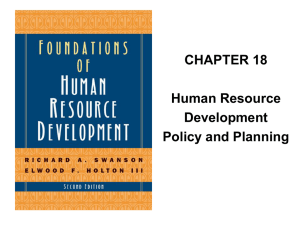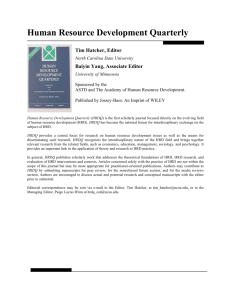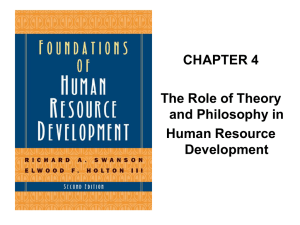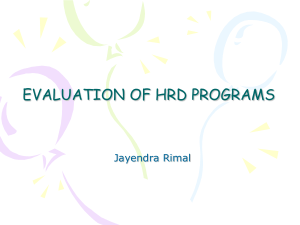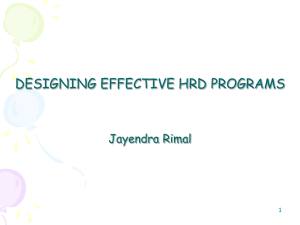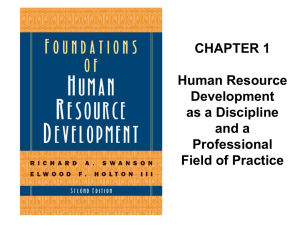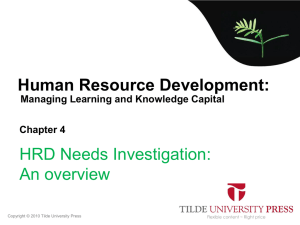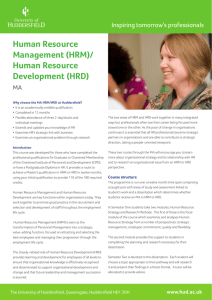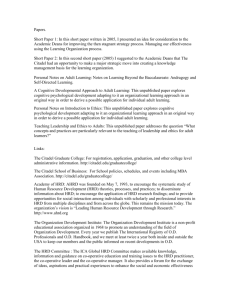8539 - Educatepk.com
advertisement
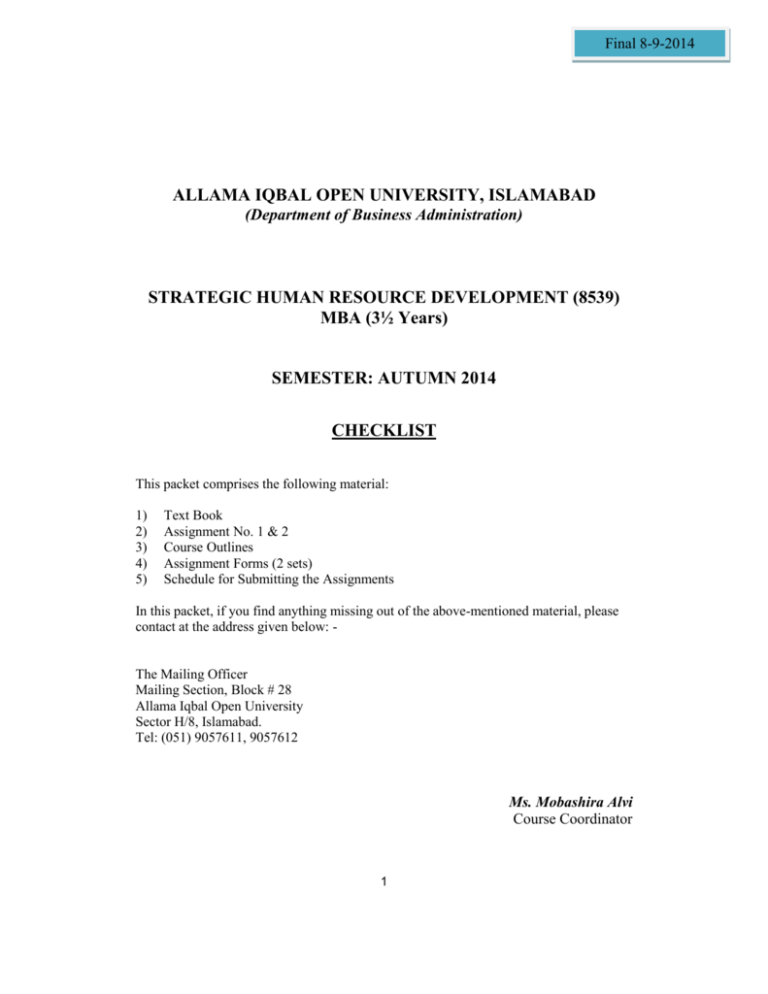
Final 8-9-2014 ALLAMA IQBAL OPEN UNIVERSITY, ISLAMABAD (Department of Business Administration) STRATEGIC HUMAN RESOURCE DEVELOPMENT (8539) MBA (3½ Years) SEMESTER: AUTUMN 2014 CHECKLIST This packet comprises the following material: 1) 2) 3) 4) 5) Text Book Assignment No. 1 & 2 Course Outlines Assignment Forms (2 sets) Schedule for Submitting the Assignments In this packet, if you find anything missing out of the above-mentioned material, please contact at the address given below: - The Mailing Officer Mailing Section, Block # 28 Allama Iqbal Open University Sector H/8, Islamabad. Tel: (051) 9057611, 9057612 Ms. Mobashira Alvi Course Coordinator 1 ALLAMA IQBAL OPEN UNIVERSITY, ISLAMABAD (Department of Business Administration) WARNING 1. PLAGIARISM OR HIRING OF GHOST WRITER(S) FOR SOLVING THE ASSIGNMENT/S WILL DEBAR THE STUDENT FROM AWARD OF DEGREE/CERTIFICATE, IF FOUND AT ANY STAGE. 2. SUBMITTING ASSIGNMENT(S) BORROWED OR STOLEN FROM OTHER/S AS ONE’S OWN, WILL BE PENALIZED AS DEFINED IN “AIOU PLAGIARISM POLICY”. Course: Strategic Human Resource Development (8539) Level: MBA (3½ Years) Semester: Autumn 2014 Total Marks: 100 Pass Marks: 50 ASSIGNMENT No. 1 (Units: 1–5) Note: Attempt all questions. Q. 1 What is HRD and explain how SHRD differs from HRD Strategies? (20) Q. 2 Discuss roles played by staff and management in HRD process. (20) Q. 3 Discuss the importance of learning support for non-employees in HRD. (20) Q. 4 Discuss the following: a) Compare and Contrast HRM and HRD. b) Differentiate between HRM and personnel management. (10) (10) Q. 5 Discuss the role of marketing in HRD with examples. (20) GUIDELINES FOR ASSIGNMENT No. 1: You should look upon the assignments as a test of knowledge, management skills, and communication skills. When you write an assignment answer, you are indicating your knowledge to the teacher: Your level of understanding of the subject; How clearly you think? How well you can reflect on your knowledge & experience? How well you can use your knowledge in solving problems, explaining situations, and describing organizations and management? How professional you are, and how much care and attention you give to what you do? To answer a question effectively, address the question directly, bring important related issues into the discussion, refer to sources, and indicate how principles from the course materials apply. You must also be able to identify important problems and implications arising from the answer. 2 For citing references, writing bibliographies, and formatting the assignment, APA format should be followed. ASSIGNMENT No. 2 Total Marks: 100 Pass Marks: 50 This assignment is a research-oriented activity. You are required to submit a term paper and present the same in the classroom prior to the final examination. Presentation component is compulsory for all students. You will have to participate in the activity fully and prepare a paper of about 15 to 20 pages on the topic allotted to you. The students are required to prepare two copies of Assignment No. 2. Submit one copy to your teacher for evaluation and the second copy for presentation in the classrooms in the presence of your resource persons and classmates, which will be held at the end of the semester prior to final examination. Include the following main headings in your report:a) Introduction to the topic b) Important sub-topics c) Practical aspects with respect to the topic d) Review of theoretical and practical situations e) Merits, demerits, deficiencies or strengths of the organization with respect to your topic f) Conclusions and recommendations g) Annex, if any You must use transparencies, charts or any other material for effective presentation. To avoid the duplication, a student is required to select the topic according to the last digit of his/ her role number. For example if your roll number is I-342718 then you will select topic # 8 from the given below list (last digit): 1 2 3 4 5 As there are five topics, you have to select the topic according to the last digit mentioned as under: Topic Last digit of the role number 01,3 12,4 25,7 36,8 40,9 List of Topics 0. Learning Organizations 1. Strategic Alliances. 2. Transformational Change. 3. SME and HRD. 3 4. TQM and HRD. STRATEGIC HUMAN RESOURCE DEVELOPMENT DETAILED COURSE OUTLINE (8539) Unit–1: Strategic Human Resource Development I. 1.1. Introduction to Strategic Management 1.2. Systematic Strategic Analysis Model 1.3. Evaluation of Strategy Emerging Concept of Human Resource Development 1.4. Introduction to Human Resource Development 1.5. Rationale Behind Term Human Resource Development 1.6. Recent Approaches to Human Resource Development 1.7. Scope of Human Resource Development Unit–2: HRM and HRD I. 2.1. 2.2. 2.3. 2.4. 2.5. 2.6. 2.7. 2.8. II. 2.9. 2.10. 2.11. 2.12. 2.13. 2.14. Strategic HRD versus HRD Strategies When Does Human Resource Development Strategy become “Strategic”? Piecemeal of Human Resource Development Strategies Training Strategies Contribution to Strategic Human Resource Development From “Training” to “Training and Development” Strategy From “Training and Development” to “Strategic Human Resource Development” Formal Planning Model for Strategic Human Resource Development Linking Strategic Human Resource Planning and Development Importance of Consistencyin Human Resource Development Strategies HRM versus Personnel Management and its Implications for HRD Human Resource Management versus Personnel Management Claims for Distinctiveness of Human Resource Management Other Perspective on Human Resource Management Requirement for Human Resource Management Emergence Human Resource Management versus Personnel Management in Practice Relationship between HRM and HRD Unit–3: Human Resource Development Roles and Relationships 3.1. Difference Between Task (functional) and Process (Interpretive) Roles 3.2. Relationship Between HRD Function and the Line 3.3. Increasing Role of Line Management in the HRD Process 4 3.4. 3.5. 3.6. 3.7. 3.8. 3.9. 3.10. 3.11. 3.12. Emerging Partnership Role of Top Management Role of Line Management Mentoring Coaching Role of Line Management in Delivery Learning Appraisal and Performance Management Advocacy Role of Staff in Human Resource Development Role of Human Resource Development Specialist in Process Unit–4: Marketing the Human Resource Development Function 4.1. 4.2. 4.3. 4.4. 4.5. 4.6. 4.7. 4.8. Market Segmentation Classifying Learners by Market Segment Customer Analysis Marketing Mix Marketing Plan versus Marketing Strategy Types of Marketing Strategy Some Problems with Adopting a Marketing Perspective in HRD Marketing of Learning - Supporting HRD Function Unit–5: Strategic Human Resource Development and Peripheral Activities I. 5.1. 5.2. 5.3. 5.4. II. 5.5. 5.6. 5.7. 5.8. 5.9. 5.10. 5.11. Career Development in Downsized Organizations Career Development as a Strategic Theme Career Anchors Traditional Notion of a Career Current Trends Provision of Learning Support for Non-Employees Non-Employees Stakeholder Analysis Value Chain and Vertical Integration Impact of Outsourcing on Non-Employee Learning Needs Non-Employees - Contribution to the Primary, Support Value Chain Non-Employee Learning Outsized the Value Chain Orchestration of Learning Process for Non-Employees Outsourcing What Stays In and What Goes Out Unit–6: Quality Management of Human Resource Development 6.1. 6.2. 6.3. 6.4. 6.5. Process Benchmarking Benchmarking and Human Resource Development Practices and Human Resource Development Benchmarking and Organizational Learning Global Benchmarking and Human Resource Development 5 I. 6.6. 6.7. 6.8. 6.9. Total Quality Management and Human Resource Development Background to Total Quality Management Quality Circles Labeling the Total Quality Management Effort Total Quality Principles in 1990’s Unit–7: Types of Organizations and Human Resource Development I. II. Small and Medium-Sized Enterprises and Human Resource Development 7.1. Formal Training in Small and Medium Sized-Enterprises 7.2. Informal and Accidental HRD Processes and the Development of Tacit Skills 7.3. Differentiating Between Small and Medium Sized-Enterprises for HRD Purposes 7.4. Developing Structured HRD Initiatives in Small and Medium SizedEnterprises Learning Organization 7.5. Three Level of Learning in Organizations 7.6. Learning Organization Frameworks 7.7. Development Perspective Towards Becoming a Learning Organization 7.8. Implications for Human Resource Development Practitioners Unit–8: Maximizing Profits by Change and Marketing Strategies I. II. Managing Transformational Change from a Human Resource Development Perspective 8.1. Transformational Change versus Transactional Change 8.2. Transitional Change 8.3. Incremental Change 8.4. Organizational and Individual Dynamics in the Change Process 8.5. Handling the Interplay of Forces 8.6. Paradoxes of Transformational Change 8.7. Stages in the Management of Transformational Change from a HRD Perspective 8.8. Evaluation of Transformational Change Role of HRD in Creating Synergy among Business Units and SubUnits 8.9. Creating Synergies in Existing Organizations 8.10. The “everything but” Rule 8.11. Horizontal Strategy 8.12. Synergy and Diversification 8.13. Strategic Alliances 6 8.14. Human Resource Development Strategies to Enhance Synergy 7 Unit–9: Global Perspective I. 9.1. 9.2. 9.3. 9.4. 9.5. II. 9.6. 9.7. 9.8. III. 9.9. 9.10. 9.11. 9.12. 9.13. Operating in Global Environment Four Approaches to Operating Internationally Global Mindset Target Market for Human Resource Development Interventions Cross-Cultural Issues Human Resource Development Contribution Working in the Virtual Organization Virtual Organization as a Network Virtual Organization and Electronic Technology Human Resource Development Implications Organizational Values Objective versus Values Types of Organizational Values Values of Commitment in the Literature Values of Human Resource Development Practitioners Manifestation of Values in Specific Areas Recommended Books: Walton J. Strategic Human Resource Development. New Jersey, U.S.A.: Prentice Hall. ____[]____ 8
